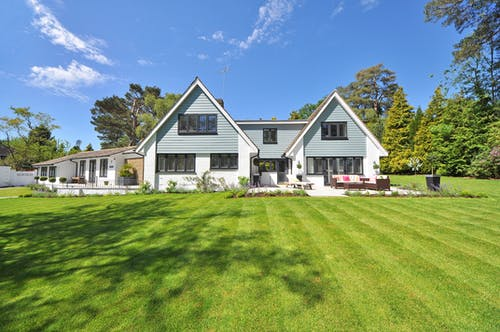Lawn maintenance is an all-American hobby that is loved by millions. But creating and maintaining a lush yard can be very confounding for less experienced homeowners. There are many things to consider and the novice horticulturist can quickly get in over their head.
Sometimes things go south with lawn maintenance and you might find yourself watching your lawn slowly die without any idea about what to do to remedy the situation. And it’s no laughing matter.
Having a poorly maintained lawn can damage your property value, and it’s likely that a good portion of your life is tied up into maintaining the value of your life’s biggest investment, your real-estate. Having a dead or dying lawn may even open you up to fines from your HOA, or worse.
Listed within this article are some of the major things to consider when creating, designing, and maintaining your lawn.
1. Watering
Watering your yard is one of the fundamental things about keeping a yard lush and green. While it’s possible to over-water your yard, most issues related to watering are due to lack of enough water. Grass yards are notoriously thirsty for the wet stuff, and they need plenty of it to stay full and green.
However, standing in your yard with a hose for 30 minutes a day might not be your idea of time well spent. In that case, a sprinkler system is a good solution. If designed correctly, it also ensures even and sufficient coverage while you are freed up to do the work that you need to do. SA Sprinkler is a well-known educator and installer of sprinkler systems. Their website demonstrates the possible outcomes of a sprinkler system and you can get a good idea of the possibilities.
2. Reseeding And Feeding
lawn aeration is lacking the fullness or depth of color that you desire, the solution is probably in reseeding(overseeding) and feeding.
Improperly maintained lawns become sparse and scrubby over time due to poor watering, lack of fertilization, or lack of soil maintenance.
To fix this situation, a lawn owner must reseed and feed their lawn. Typically, this is done by using a seed thrower to spread a mix of seed and fertilizer all over your lawn. Even if your lawn looks good, overseeding thin areas of the yard will provide a more consistent and satisfying look.
3. Aeration
If you’ve been doing a good job of watering, seeding, and feeding but you aren’t seeing the results that you expect, you should consider aerating your yard.
Soil can become hard and compact over time, especially if you have a lot of clay in your soil. When this happens there is no space for water, nutrients, and oxygen to permeate the soil. This causes the grass to die in these regions. Or if your entire yard isn’t performing well, you might consider aerating the entire yard.
Aeration utilizes a special tool that removes little cores of soil from the yard. You can find handheld tools that remove as little as a single core at a time, or you can rent a gas-powered aerator designed to cover a lot of yardage in a hurry.
Your choice of aeration tool depends on your needs. If you’re just breaking up small patches, then the handheld tool is perfect. However, if you believe your entire yard needs aeration, you had better rent the tool. That or spend weeks removing thousands of soil cores one at a time.
Even if your lawn is performing nicely, aeration still needs to be done annually if you want the best-looking lawn possible.
4. Thatch Removal
Thatch removal is often overlooked by homeowners, but it has drastic effects on the quality of your lawn’s appearance. Thatch is the organic debris that builds up within your yard. It’s made up of old grass clippings, dead weeds, and miscellaneous fiber that gets lodged within the thickness of your yard. It’s the old bits of grass and vegetation that you sometimes drag up with the rake.
Thatch tends to build up in yards that are particularly thick and lush because the errant fibers get stuck in the tightly packed body of the yard. Yards that have weed problems are also prone to long stringy thatch made of vines and runners that make it difficult to remove.
Thatch removal opens up much-needed real-estate within the body of your yard. It provides extra room for oxygenation and provides the space needed for your lawn to thicken and become as lush as possible.
5. Weeding
Finally, weeding is a well-known but oft-neglected aspect of lawn care. Shrugging the responsibility of weeding your yard can have devastating consequences for your yard’s appearance and practicality.
Weeds themselves can present an obvious problem if you’ve got an infestation of burrs, thorny runners, or even poison ivy. In less obviously unpleasant cases, weeds can lead to a variety of annoying problems that make your job of lawn maintenance much more difficult.
Weeds take up valuable nutrients and space. Their tendency towards invasive vines and runners leads them to strangle your yard when they are alive. And after they die, their difficult and fibrous nature is a major contributor to the build-up of thatch that is particularly hard to remove.
Comprehensive Lawn Care Requires Knowledge
Regardless of your lawn’s particular issues and needs, there is always a solution to your problem. Many homeowners become discouraged when their lawn starts to die because they don’t have the know-how to remedy the situation.
If you find yourself in this situation, it’s likely that one of the preceding issues is to blame. Give your lawn the careful consideration that it deserves by familiarizing yourself with the major issues and determining the actions that will benefit your lawn the most.

